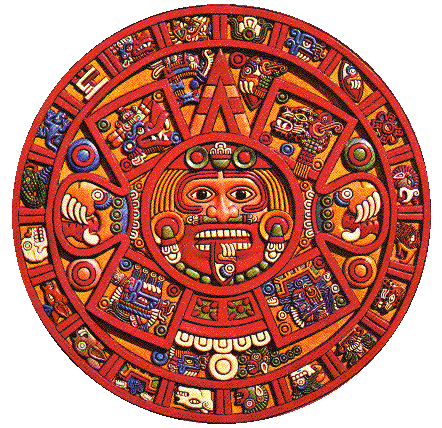-Valley of Anahuac, New Year’s Eve, 1507.
Tenochtitlán, the great island city, capital of the Mexica empire, lies cloaked in darkness. An eerie silence pervades the vast ceremonial center — the Teocalli or Templo Mayor — spreading out over Moctezuma’s splendid palace, with its botanical gardens and well-stocked zoo, across the market places, canals, aqueducts, and within each of the humble abodes in the residential wards.
For five full days, activity in the normally bustling metropolis has ceased. Commerce has been suspended, ceremonial and household fires extinguished, clothing, furniture, crockery and religious idols torn, broken and smashed. It is a time of fasting, sexual abstinence and uneasy waiting. But the nemotemi — empty days — that mark the end of the solar cycle are about to come to an end.
At the summit of Uixachtecatl — the Star Hill — overlooking Tenochtitlán, the city’s astronomer-priests anxiously watch the heavens. Each is outfitted in the image of one of their many gods. They await nature’s sign, for not until the Pleiades appear on the horizon can the sacred New Year’s ritual begin.
Finally a noble captive is guided to the sacrificial stone. At the moment the brilliant star cluster reaches its zenith the priests jump into action. With one swift stroke of a razor-sharp obsidian knife they slash open their honored victim’s chest. They work furiously to kindle fire within the gaping wound, and as the first spark turns to flame, cut out the heart, casting it upon a brazier. One by one, a line of waiting couriers step forward to ignite their torches, then turn back towards the darkened city to relay the New Fire first to the altars of the Templo Mayor and thence to every temple and hearth throughout the empire.
For the next 12 days Tenochtitlán will erupt in unbridled festivity, for this ceremony marks not only the commencement of the new xiuhmolpilli — year bundle — but also the start of a new 52-year calendar cycle. According to Mexica belief, if the New Fire failed to ignite, the sun would surely perish.  But on this night it seemed that the gods were pleased; El Quinto Sol — the Fifth Sun — would continue to illuminate the Mexica Empire. Once again the forces of darkness had been routed by the powers of light.
But on this night it seemed that the gods were pleased; El Quinto Sol — the Fifth Sun — would continue to illuminate the Mexica Empire. Once again the forces of darkness had been routed by the powers of light.
Or had they? We can only surmise the above scenario of that final New Fire ritual and wonder whether the wise priests perceived some augur of their civilization’s imminent doom. Did they in fact forsee that only a few years hence the mighty Tenochtitlán would be laid to waste, that the foundations of another metropolis would be created from the rubble of their lofty temples? Did they envision that conquerers from a distant land would be so indifferent to their accomplishments, so reviled by their religious customs that all evidence of the Mexica culture would be systematically destroyed and suppressed for generations to come?
As it happened, the Empire of the Mexicas (or Aztecs as the Spanish called them) fell to Cortés and his Conquistadores in 1521. Within a few short years the heathen temples were obliterated and valuable records, such as friar Bernardino de Sahagún’s codices — a 12-volume encyclopedia of Aztec life and culture — secreted and gathering dust.

Widespread interest in Mexico’s pre-Hispanic past was not awakened until 1790, when an astonishing artifact was uncovered during a renovation of el Zócalo, Mexico City’s central plaza. It was a massive disk of carved basalt, three feet thick and 12 feet in diameter, weighing some 24 metric tons. A veritable monument to art and science, the monolith initially remained at the Zócalo, embedded for viewing in the base of the west tower of the Metropolitan Cathedral. A hundred years later it was transferred to Mexico’s National Museum of Anthropology, where today it stands as the institution’s centerpiece.
Following the first intepretations of the intricately carved hieroglyphs it was labeled the Aztec Calendar Stone. In current thought Stone of the Fifth Sun is considered a more apt moniker. Though scholars have long debated the stone’s meaning and purpose, they still puzzle over its many mysteries. Some suggest that, fixed horizontally, it served as a sacrificial altar. Most now agree that it offers a graphic representation of the Mexica cosmos.
The stone’s outer rim shows two fire serpents meeting face to face at the lower extreme. Their tails are joined at the top with the symbol for the ritual date 13-Reed, considered to represent the creation, possibly corresponding to 1011 A.D. Looking out from the center of the stone is the sun god Tonatuih. His tongue, in the form of a sacrificial flint knife, protrudes from between his bared teeth, while in each claw-like hand he grasps a human heart. The god is surrounded by four glyphs symbolizing the cataclysms that ended each of the prior solar eras. According to Mexica belief, earth’s earliest inhabitants were devoured by jaguars. The demise of the second sun brought destruction by great winds. The third era ended with fiery rain, while the fourth sun was extinguished by massive floods.
These symbols, together with the image of Tonatuih, are neatly contained in the abstract motif for motion called ollin. It is surmised that the stone reveals the predicted date of destruction for El Quinto Sol during a 4-Ollin cycle. The Mexicas attempted to preserve their era, forestalling catastrophe by sating the gods with myriad rituals and sacrifices, including a steady diet of human blood.
In fulfilling their sacred duties to some 1,600 deities, the Mexicas adhered to a complex calendar system. There was a civil calendar made up of 18 months of 20 days each, which with the ominous nemontemi brought the total of the solar year to a tidy 365 days. A second sacred calendar — the tonalpohualli — was an ancient ritualistic almanac, probably adopted from the Mayan culture, comprising 260 days. Each 24-hour cycle was designated by one of 20 day names plus a number from 1 to 13. A band of the 20 day-sign gylphs encircles the Sun Stone’s center.
The formula by which the two calendars were combined meant that no one date would be repeated for a period of 18,980 days. Thus the last day of a solar cycle and the last day of a sacred cycle coincided just once every 52 years. It was on this auspicious occasion that El Quinto Sol was considered in greatest jeopardy of extinction. A successful New Fire ceremony would assure the the reappearance of the orb and continued survival of human civilization.
The intercalation of a 12-day New Fire festival period once every 52 years brought the Mexicas into nearly perfect synchronization with the true cycles of earth and sun. Modern scientists calculate the tropical year to be precisely 365.2422 days. While the Gregorian calendar currently in use allots 365.2425 days for each year, the remarkable Mexicas were a bit closer to the mark at 365.2420 days.
This is just one of many unsolved mysteries that promise to keep the Mexica’s Kingdom of the Sun a subject of fascination so long as Tonatuih — the luminous one — shines upon our earth.
(This article originally appeared in the January, 1993 edition of El Ojo del Lago. With some recent revisions by the author, it is reproduced here with her kind permission, as well as that of the publisher.)


